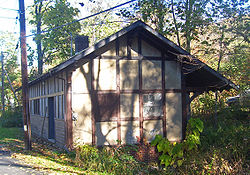- O & W Railroad Station at Port Ben
-
O & W Railroad Station at Port Ben
 North elevation and west profile, 2008
North elevation and west profile, 2008Location: Wawarsing, NY Coordinates: 41°44′57″N 74°20′56″W / 41.74917°N 74.34889°WCoordinates: 41°44′57″N 74°20′56″W / 41.74917°N 74.34889°W Area: 13.5 acres (5.5 ha)[2] Built: 1912 Architectural style: Tudor Revival Governing body: Private NRHP Reference#: 01001448[1] Added to NRHP: January 11, 2002 The abandoned O & W Railroad Station at Port Ben is located on Tow Path Road in the Town of Wawarsing, New York, United States. It is a Tudor Revival style building erected in the early 20th century by the New York, Ontario and Western Railway (O & W) and closed a few decades later.
Despite the passage of half a century since it was last used, and its abandonment and neglect since then, it has remained intact and well-preserved. In 2000 the station and the right-of-way used by the now-removed tracks were listed on the National Register of Historic Places.[1]
Contents
Building
The station is in the small community of Port Ben, located a short distance east of the US 209 highway north of Napanoch on the east bank of Rondout Creek at the foot of the Shawangunk Ridge. It is on the northeast edge of Port Ben, a small community of small frame houses and modular and mobile homes. To the immediate east of the station is the empty bed of the Delaware and Hudson Canal, a National Historic Landmark.
Towpath Road on the west of the station, which served that purpose during the canal's years of operation in the 19th century, was later used as the railroad's right-of-way. The 4,700 feet (1.4 km) of that right-of-way remaining next to the station is still visible even where it has not been used as a road, and is included in the Register listing as a contributing resource, bringing the total area of the listing to 13.5 acres (5.5 ha).[2]
The building itself is a single story, two-by-six-bay, wood frame building on a brick foundation with a low pitched gable roof shingled in slate. It is pierced by a brick chimney at the north end. Brackets support its wide overhanging eaves.[2]
It is faced in half-timbered beige stucco on a metal lath. Some of the exterior has been defaced with spraypainted graffiti. Fenestration is irregular, determined by the building's use as a rail station. On the south (front) side is an off-center projecting trainmaster's window and separate passenger and freight doors. The north (rear) has square windows in pairs and singled and a freight entrance near the west end. That end has two square windows, one currently boarded up, matched by a passenger entrance and window at the east.[2]
Inside the space is divided into a passenger waiting area in the east, ticket office in the center and freight office on the west. Many of the original finishings remain, including the lath and plaster walls, the varnished wainscoting and door and window surrounds. The electrical switches are still in place, and some coal remains in the bin.[2]
History
The O&W, originally the Oswego Midland Railroad, was chartered in the late 1860s to connect that Lake Ontario port city with New York City. Shortly after it opened, the Panic of 1873 put it under great financial distress, and by 1879 it was renamed by new ownership. It slowly began to grow throughout the remainder of the century, running small branch lines in Orange and Ulster counties, with a connection to Scranton, Pennsylvania, and its coal shipments.[2]
In 1902 it began building a branch along the route of the former Delaware and Hudson Canal, which had closed down in that area two years before. In 1912 it was complete to Cottekill, near Kingston, and the Port Ben station was opened. The station followed a standard plan for rural rail depots of the area, with the use of Tudor Revival giving it the feel of a resort-area station.[2]
The O&W continued operating the line throughout the first half of the century, but always with great financial difficulty. It finally declined after World War II with the rise of the automobile, and passenger operations ceased in 1950, shortly before the line itself was closed down. In the late 1950s, the tracks were removed. The station has remained intact and unused since then.[2]
See also
- National Register of Historic Places listings in Ulster County, New York
- Ontario and Western Railroad Passenger Station, another surviving station on the same branch
References
- ^ a b "National Register Information System". National Register of Historic Places. National Park Service. 2009-03-13. http://nrhp.focus.nps.gov/natreg/docs/All_Data.html.
- ^ a b c d e f g h John A. Bonafide (July 2001). "National Register of Historic Places Registration: O & W Railroad Station at Port Ben". New York State Office of Parks, Recreation and Historic Preservation. http://www.oprhp.state.ny.us/hpimaging/hp_view.asp?GroupView=9860. Retrieved 2010-03-20. See also: "Accompanying eight photos". http://www.oprhp.state.ny.us/hpimaging/hp_view.asp?GroupView=9831.
Categories:- Defunct railway stations in the United States
- National Register of Historic Places in Ulster County, New York
- Railway stations on the National Register of Historic Places in New York
- Buildings and structures completed in 1912
- Railway stations opened in 1912
- Railway stations closed in 1953
- Tudor Revival architecture in New York
- Wawarsing, New York
Wikimedia Foundation. 2010.



